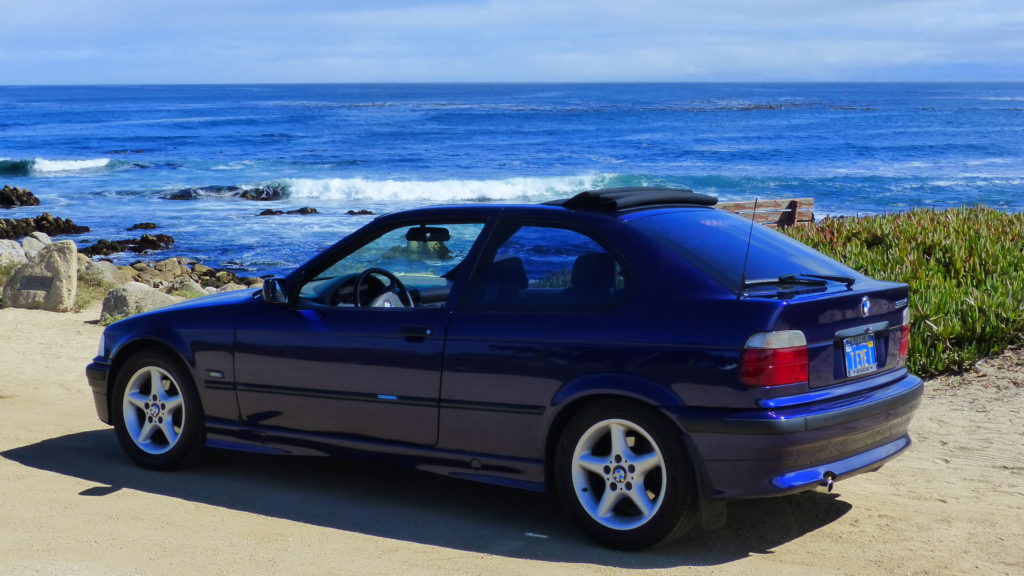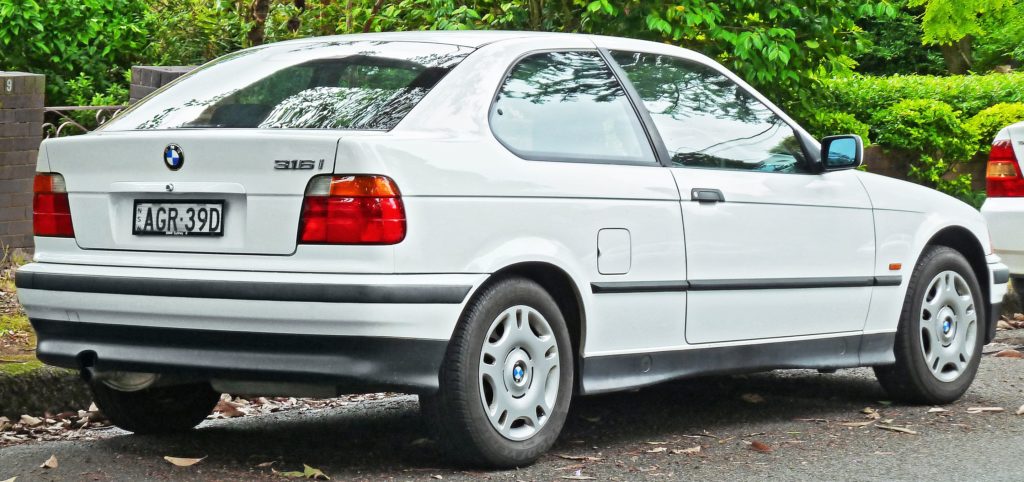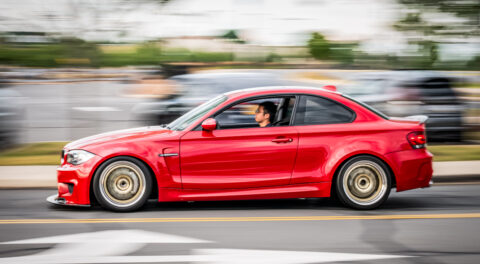There are certain cars that are both loved and hated by true car enthusiasts. The Nissan Cube springs to mind; some loved the practicality and quirkiness that the Cube offered, and some just couldn’t get over the asymmetrical styling features. Even while Tesla outsells its competition, it still maintains a polarizing “love it or hate it” status in the enthusiast world. It’s not unlike the Chrysler PT Cruiser—just kidding, nobody liked the PT Cruiser.
In the BMW community, the car that always filled this category of polarization was the Z3 “Clown Shoe” coupe—that is, until everyone realized that it was two-door sports-car-packaging perfection—and now they’re worth impressive money.
So, what’s the next polarizing BMW to catch the wave? I’m here to make a case for the 318ti. As you read that, you probably already made a decision on the car. In the five years I’ve owned mine, I’ve seen no neutral responses, and instead find people are either in the “It’s ugly, where’s the rest of it?” camp, or “I’ve always wanted one of those!”
Since I’m an obvious member of the latter camp, I’d like to dispel all doubts about the 318ti’s controversial looks by selling you on one hard-to-ignore fact: This car can do everything. Since the old saying goes, “Cheap, reliable, fast: pick two,” let’s address these three pillars in the context of my eccentric hatchback.

Matt Schwartz’ E36 318ti, complete with California roof and T EYE I plates.
Cheap
According to Kelley Blue Book, the trade-in value of my California Edition 318ti (in excellent condition) is only $1,100 at the most. While this is relevant mainly for dealer transactions, it’s still very common to see 318ti’s for sale for under $4,000. Only on exclusive auction site Bring a Trailer have we seen a few 318tis auctioned for more than $10,000. These include outliers, like M3-swapped cars or the ever-elusive Club Sport Edition (of which only a few hundred were originally sold).
Even after purchase price is considered, a ti is still “cheap” when factoring in general maintenance. It’s rare to find replacement parts that cost more than $100. Refreshing the vacuum system, which only takes a few hours, can be completed mostly with hoses from Autozone. The PCV valve I just replaced was about $31. The OEM oxygen sensor was $64.
Oh, and in the stock configuration, a well-tuned M42 or M44 will yield 25 MPG in mixed driving; it’s not uncommon to see up to 33 MPG on long highway trips.
The only things that can get expensive in ti-dom are replacement interior pieces, since they came with many wacky and colorful patterns that the other E36 models weren’t as lucky to receive. Mine has a very light gray cloth that stains when you breathe too close to the seats. So please, stay away.

An Australian-market 316i—a reminder that the North American 318ti can, in fact, be slower.
Reliable
I’ve owned my ti for five years and have covered roughly 40,000 miles in that time. Those miles were mostly on unfamiliar roads, and occasionally unfamiliar terrain. While it’s reasonable to have some form of anxiety when driving an older vehicle in a new area, I’ve never felt particularly uneasy about taking a long trip. During the last half-decade, I’ve been through 25 different states in the ti, through varying weather conditions—I’ve seen the ambient temp gauge read triple digits, and I’ve also seen it read 1º Fahrenheit while driving in Chicago snow. (I was never brave enough to leave the house in negative temps.)
The only time I needed a tow was two weeks after I bought the car in 2014, when it got a flat tire. I learned my lesson: Look at the date stamp on your tires before you take a cross-country road trip! I got another flat from a puncture while attending BMW CCA O’Fest at the Pittsburgh Vintage Grand Prix in 2018, but I was able to limp the car to a Discount Tire location (shoutout to that sweet, sweet road-hazard warranty).
There was one occasion where my temperature gauge began to creep up, but it stopped before actually overheating. Turned out it was a bad resistor on the fan; it was replaced with a $10 part from Amazon, along with a new thermostat.
Now, it’s important to disclose that I have been fastidious with maintenance, often replacing things preventively just so they don’t become issues in the future. Doing this will prevent headaches and issues with any car, not just an E36. Once the car reached 95,000 miles, I realized that I was still running a mostly original cooling system, so I had almost all of it replaced. Preventive maintenance will make almost any car reliable, especially an E36, since the M4x engine is fairly reliable.

BMW only made one E36 M3 Compact prototype, but that doesn’t mean the U.S.-market 318ti is without some of that performance spirit.
Fast
Obviously, this is the controversial one, so I saved it for last. One of the reasons why the ti wasn’t as popular with enthusiasts is that it was considered slow, especially when compared with the conventional six-cylinder variants. If BMW offered a six-cylinder hatchback in the states, it probably would’ve sold rather well.
While I can’t pretend that the ti is fast enough to beat a lot of sports cars to 100 mph, I can attest to how quick it is. A car that was designed to be used in cities doesn’t really need to be fast, it just needs to be quick and nimble. The ti is a fantastic momentum car—it holds speed extremely well, especially through the corners. Once it’s up to speed, the engine can be quite torquey between 3,000 and 4,000 RPM, making it fairly easy to pass other cars on the highway.
Much like a 2002, the ti reminds me of an old allegory: “It’s more fun to drive a slow car fast than a fast car slow.” Even though it only has about 140 horsepower, you end up using that power all the time, which is what these engines prefer. They’re rev-happy, and they encourage you to wind through the gears, but once you get to the top of third, you’ll be close to the speed limit. It’s basically a built-in speeding-ticket defense system.

Matt Schwartz’ 318ti appeared at Radwood in Los Angeles during December 2019.
Practical
The one thing that hasn’t been addressed yet is just how usable a 318ti is. Even given all of the above, the overall usability and practicality of a ti is what makes it a special E36. The cargo capacity with the seats folded up is fifteen cubic feet, and the large opening due to the hatch makes loading and unloading incredibly easy. With the rear seats folded down, the storage volume is more than double that: a ridiculous 36 cubic feet. I’ve moved across the country more than twice in my ti. One time I was able to fit two bicycles, two guitars, a small shelving unit, and every piece of clothing I owned behind the front seats—all of this in a car smaller than a new Camry.
Only time will tell if the E36 ti will stay affordable, but they will forever be practical, especially in a world where a brand-new inexpensive car still has a myriad of sensors that fail at every sneeze. My suggestion: Get a ti soon, because finding one that isn’t clapped out and taped back together is becoming increasingly difficult. Then you’ll be able to carve canyons with all of your stuff in the back, including all of the cash you saved by not buying a newer BMW. You won’t regret it.—Matt Schwartz
[Photos courtesy of BMW AG, Wikimedia Commons, Kyle Van Hoften, Matt Schwartz.]
This article was submitted by BMW CCA member Matt Schwartz. Interested in submitting your own article? E-mail articles@bimmerlife.com!




















